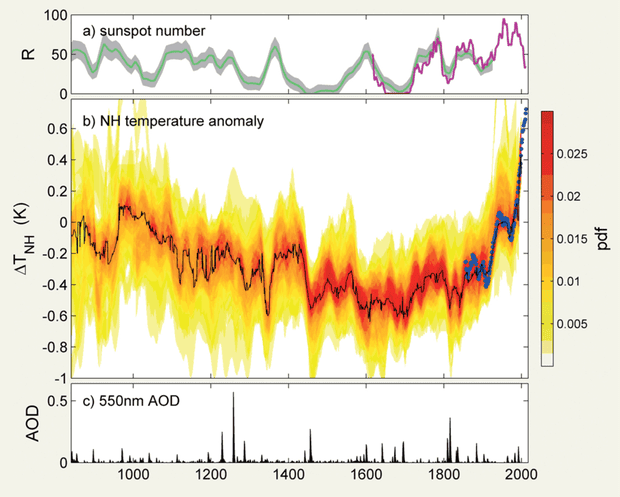
This post has been incorporated into the rebuttal to the myth A grand solar minimum could trigger another ice age
Roughly every two years we’re treated to headlines repeating the myth that Earth is headed for an imminent “mini ice age.” It happened in 2013, 2015, and again just recently at the tail end of 2017.
This time around, the myth appears to have been sparked by a Sky News interview with Northumbria University mathematics professor Valentina Zharkova. The story was quickly echoed by the Daily Mail, International Business Times, Sputnik News, Metro, Tru News, and others. Zharkova was also behind the ‘mini ice age’ stories in 2015, based on her research predicting that the sun will soon enter a quiet phase.
The most important takeaway point is that the scientific research is clear – were one to occur, a grand solar minimum would temporarily reduce global temperatures by less than 0.3°C, while humans are already causing 0.2°C warming per decade.

The global mean temperature difference is shown for the time period 1900 to 2100 for the IPCC A2 emissions scenario. The red line shows predicted temperature change for the current level of solar activity, the blue line shows predicted temperature change for solar activity at the much lower level of the Maunder Minimum, and the black line shows observed temperatures through 2010. Illustration: Adapted from Feulner & Rahmstorf (2010) in Geophysical Research Letters by SkepticalScience.com
So the sun could only offset at most 15 years’ worth of human-caused global warming, and once its quiet phase ended, the sun would then help accelerate global warming once again.
The myth ultimately stems from a period climate scientists have coined “The Little Ice Age” (LIA). This was a modestly cool period running from about the year 1300 to 1850. It was particularly cold in the UK, where the Thames River sometimes froze over, and ‘frost fairs’ were held.
A team led by University of Reading physicist and solar expert Mike Lockwoodwrote a paper reviewing the science behind frost fairs, sunspots, and the LIA. It included the figure below showing northern hemisphere temperatures along with sunspot number and the level of volcanic particles in the atmosphere over the past millennium:

Sunspot number, northern hemisphere temperatures, and volcanic aerosol optical depth (AOD) around the time of the Little Ice Age. Illustration: Lockwood et al. (2017), News & Reviews in Astronomy & Geophysics
During full blown ice ages, temperatures have generally been 4–8°C colder than in modern times. As this figure shows, during the LIA, temperatures were at most only about 0.5°C cooler than the early 20th century. Thus, Lockwood calls the Little Ice Age “a total misnomer.” As the authors put it:
Compared to the changes in the proper ice ages, the so-called Little Ice Age (LIA) is a very short-lived and puny climate and social perturbation.
For comparison, temperatures have risen by a full 1°C over the past 120 years, and 0.7°C over just the past 40 years.
The Maunder Minimum was a period of quiet solar activity between about 1645 and 1715. It’s often referred to interchangeably with ‘Little Ice Age,’ but the latter lasted centuries longer. In fact, three separate solar minima occurred during the LIA, which also included periods of relatively higher solar activity. Other factors like volcanic eruptions and human activities also contributed to the cool temperatures. In fact, a 2017 paper led by the University of Reading’s Mathew Owens concluded:
Climate model simulations suggest multiple factors, particularly volcanic activity, were crucial for causing the cooler temperatures in the northern hemisphere during the LIA. A reduction in total solar irradiance likely contributed to the LIA at a level comparable to changing land use [by humans].
Simulated northern hemisphere temperature changes resulting from individual climate factors, as compared to the observed changes in the top panel. The bottom panel shows a simulation with no changes to climatological factors, to illustrate the level of natural variability in the climate. Illustration: Owens et al. (2017), Journal of Space Weather and Space Climate
Several studies have investigated the potential climate impact of a future grand solar minimum. In every case, they have concluded that such a quiet solar period would cause less than 0.3°C cooling, which as previously noted, would temporarily offset no more than a decade and a half’s worth of human-caused global warming. These model-based estimates are consistent with the amount of cooling that occurred during the solar minima in the LIA.
Although it would have a relatively small impact on the climate, it’s still an interesting question to ask whether we’re headed for another quiet solar period. Zharkova thinks so. Her team created a model that tries to predict solar activity, and suggests another solar minimum will occur from 2020 to 2055. However, other solar scientists have criticized the model as being too simple, created based on just 35 years of data, and failing to accurately reproduce past solar activity.
Ilya Usoskin, head of the Oulu Cosmic Ray Station and Vice-Director of the ReSoLVE Center of Excellence in Research, published a critique of Zharkova’s solar model making those points. Most importantly, the model fails in reproducing past known solar activity because Zharkova’s team treats the sun as a simple, predictable system like a pendulum. In reality, the sun has more random and unpredictable (in scientific terms, “stochastic”) behavior:
Posted by dana1981 on Tuesday, 9 January, 2018
 |
The Skeptical Science website by Skeptical Science is licensed under a Creative Commons Attribution 3.0 Unported License. |